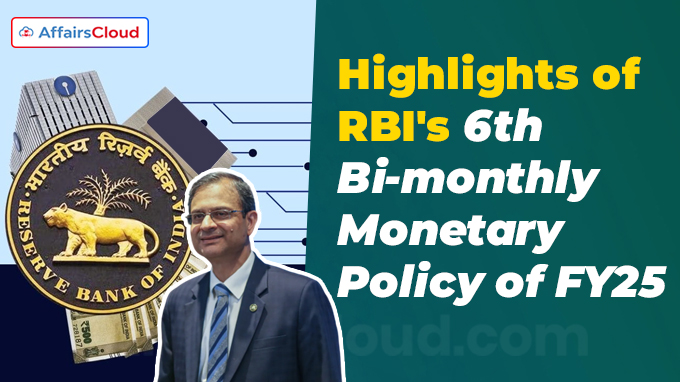 The Reserve Bank of India (RBI) Monetary Policy Committee (MPC) met from February 5 to 7, 2025 and released the 6th bi-monthly monetary policy for the financial year 2024-25 (FY 2025). This was the first meeting chaired by Sanjay Malhotra after assuming charge as RBI Governor on December 11, 2024. This session marked the 53rd meeting of the MPC and was the last one for FY 25.
The Reserve Bank of India (RBI) Monetary Policy Committee (MPC) met from February 5 to 7, 2025 and released the 6th bi-monthly monetary policy for the financial year 2024-25 (FY 2025). This was the first meeting chaired by Sanjay Malhotra after assuming charge as RBI Governor on December 11, 2024. This session marked the 53rd meeting of the MPC and was the last one for FY 25.
- The six-member committee revised the Gross Domestic Product (GDP) growth projection for FY 2025-26 (FY 26) to 6.7%, up from the earlier estimate of 6.6% for FY 25.
- The meeting was attended by MPC members Nagesh Kumar, Saugata Bhattacharya, Prof. Ram Singh, Rajiv Ranjan, and M. Rajeshwar Rao.
Key Highlights:
i.The committee unanimously decided to:
Reduce the policy repo rate under the Liquidity Adjustment Facility (LAF) by 25 basis points to 6.25%, from 6.5 % effective immediately.
ii.Consequently, the Standing Deposit Facility (SDF) rate was adjusted to 6.00%, while the Marginal Standing Facility (MSF) rate and the Bank Rate were set at 6.50%.
iii.RBI projected real GDP growth for FY 26 for Quarter 1 (Q1 April-June 2025) expected at 6.7%, Q2 (July-September 2025) at 7.0% and Q3 and Q4 at 6.5% each.
iv.RBI decided to maintain a neutral monetary policy stance and remain focused on ensuring inflation aligns with the target while fostering economic growth.
v.The next MPC meeting is scheduled to take place from April 7 to 9, 2025.
RBI’s policy Rate:
| Category | Rate |
|---|---|
| Repo Rate | 6.25% |
| Reverse Repo Rate | 3.35% |
| Standing Deposit Facility (SDF) Rate | 6.00% |
| Marginal Standing Facility (MSF) Rate | 6.50% |
| Cash Reserve Ratio (CRR) | 4.00% |
| Statutory Liquidity Ratio (SLR) | 18.00% |
| Bank Rate | 6.50% |
RBI Projects Retail Inflation at 4.2% for FY 26, Retains 4.8% Forecast for FY 25
The RBI has projected retail inflation at 4.2% for the financial year 2025-26, while maintaining its forecast for 2024-25 at 4.8%.
i.Target for Consumer Price Index (CPI) inflation is 4% within a band of +/- 2%.
CPI inflation for FY 25 remains at 4.8%, with the fourth quarter (Q4) estimated at 4.4%.
ii.For the FY 26, assuming a normal monsoon, the RBI expects inflation to be 4.2%, with quarterly estimates as follows:
Q1: 4.5%, Q2 : 4.0%, Q3 : 3.8%,Q4 : 4.2%.
iii.Retail inflation, measured by CPI, fell to 5.22% in December 2024, marking a four-month low due to a decline in food prices, particularly vegetables. In November, inflation stood at 5.48%.
RBI to Introduce ‘bank.in’ and ‘fin.in’ Domains to Enhance Cybersecurity
The Reserve Bank of India (RBI) has announced the launch of exclusive internet domains, ‘bank.in’ and ‘fin.in’, to strengthen cybersecurity in the financial sector.
- This move aims to counter rising cyber threats, particularly phishing attacks and fraudulent activities in digital transactions.
- The Institute for Development and Research in Banking Technology (IDRBT) based in Hyderabad, Telangana will serve as the official registrar for these domains.
i.The ‘bank.in’ domain will be exclusively assigned to Indian banks, offering them a secure and easily identifiable online presence.The registration process for ‘bank.in’ is expected to begin in April 2025.
ii.The fin.in’ will be introduced as a dedicated domain for non-banking financial entities. This initiative aims to further enhance security and a more reliable digital ecosystem.
RBI to Implement AFA for Cross-Border Digital Transactions
The RBI has announced plans to implement Additional Factor of Authentication (AFA) for cross-border Card Not Present (CNP) transactions.
i.Unlike domestic transactions, where AFA is already mandatory, international online payments have so far lacked this additional security check. This has left Indian consumers vulnerable when making purchases from overseas merchants.
ii.To bridge this gap, RBI has proposed extending AFA to international CNP transactions, ensuring the same level of security as domestic payments.
iii.This step aims to bring international online payments made with Indian-issued cards under the same security framework as domestic transactions by introducing an extra layer of authentication, such as a One-Time Password (OTP) or biometric verification, to reduce the risk of fraud.
RBI Allows Non-Bank Brokers Access to NDS-OM, Forms Panel on Market Timings
The RBI) has announced that non-bank brokers registered with the Securities and Exchange Board of India (SEBI) headquartered in Mumbai,Maharashtra can now directly access the Negotiated Dealing System – Order Matching (NDS-OM) platform.
- This will enable them to execute secondary market transactions in government securities on behalf of their clients.
i.The RBI has established a nine-member working group to conduct a comprehensive review of trading and settlement timings for financial markets under its regulation.
ii.The panel is led by RBI Executive Director (ED) Radha Shyam Ratho and is expected to submit its findings by April 30, 2025.
Note: Currently, NDS-OM access is limited to regulated entities, banks, and standalone primary dealers. SEBI-registered brokers can participate in the platform, subject to guidelines set by the central bank.
RBI Approves Bond Forwards to Strengthen Long-Term Investment Strategies
RBI has announced plans to allow trading in bond forwards, a financial instrument expected to strengthen an existing USD 12 billion.
i.Bond forwards will enable long-term investors, such as insurance companies and pension funds, to hedge interest rate risks over different interest rate cycles.
ii.These contracts allow investors to agree on purchasing government bonds at a predetermined future date and price, offering a structured way to manage market volatility.
iii.From March 2024 to January 2025, the notional value of bond forward rate agreements (FRA) transactions cleared through the official clearing house stood at Rs 1.1 trillion (USD 12.2 billion).
RBI Defers Implementation of LCR and Project Financing Norms to 2026
The Reserve Bank of India (RBI) has decided to postpone the implementation of the proposed Liquidity Coverage Ratio (LCR) norms and project financing guidelines by a year, with the new deadline set for no earlier than March 31, 2026.
i.This decision was made to provide sufficient time for adaptation, as the earlier timeline of April 2025 was considered too short for a smooth transition.
ii.The move aims to prevent disruptions in the financial system and ensure a stable adjustment to regulatory changes.
iii.As part of the LCR framework, banks were instructed to allocate an additional 5% as a run-off factor for retail deposits linked to internet and mobile banking (IMB). Stable retail deposits with IMB would carry a 10% run-off factor, while less stable IMB-enabled deposits would have a 15% run-off factor.
iv.LCR requires banks to maintain sufficient high-quality liquid assets (HQLAs), primarily government securities, to manage liquidity.
RBI Delays Implementation of Additional Reserve Requirement for Digital Deposits Until 2026
The RBI has decided to postpone the implementation of new guidelines requiring banks to allocate additional funds for digitally-linked deposits. Initially planned for an earlier rollout, these norms will now take effect no sooner than March 2026.
Important Definitions:
Repo Rate : The rate at which the RBI lends short-term funds to commercial banks.
Reverse Repo Rate : The rate at which the RBI borrows funds from commercial banks.
Cash Reserve Ratio (CRR) : The percentage of bank deposits that banks must keep as reserves with the RBI.
Statutory Liquidity Ratio (SLR) : The percentage of bank deposits that banks must maintain in liquid assets like cash, gold, or government securities.
Monetary Policy Stance : Whether the policy is accommodative , neutral , or tightening , depending on inflation and growth dynamics.




